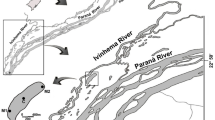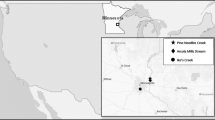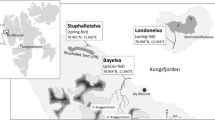Abstract
Disturbances caused by rainfall are common in streams with the impact on stream inhabitants determined by the frequency, intensity, and predictability of the event. Here, we examine the response of winter-emerging Chironomidae (Diptera) to extreme flooding disturbance. In August of 2007, a severe flood impacted southeastern Minnesota, imparting stress on aquatic communities. Chironomid pupal exuviae collections were obtained biweekly from 18 southeast Minnesota streams during the following winter to assess resistance and resilience of winter-active chironomids to flooding. Streams examined were divided into moderate (2.5–10 cm), heavy (10–20 cm), or extreme (20+ cm) rainfall categories with rainfall amounts in each category representing total precipitation during the 3-day storm. Post-flood samples were compared to samples obtained from the same localities during prior winters. Our findings contradict studies of responses by Chironomidae to flooding during warmer-water conditions and show that winter-emerging Chironomidae are resistant to stress imposed by summer spates. Significantly more taxa emerged during winter after flooding as compared to historic collections, and the number of species emerging in winter was positively correlated with rainfall severity, indicating that 15 species responded opportunistically to disturbance. This indicates that winter-active Chironomidae may be resistant to increased severity of summer spates associated with climate change predictions.





Similar content being viewed by others
References
Anderson, A. M., R. W. Bouchard & L. C. Ferrington, 2011. Hibernal emergence of Chironomidae (Diptera) in relation to stream size in Kansas, USA. In Wang, X. & W. Liu (eds), Contemporary Chironomid Studies—Proceedings of the 17th International Symposium on Chironomidae. Nankai University Press, Tianjin, China: 247–255.
Armitage, P. D., 1995a. Behaviour and ecology of adults. In Armitage, P. D., P. S. Cranston & L. C. V. Pinder (eds), The Chironomidae: The Biology and Ecology of Non-biting Midges. Chapman and Hall, London: 194–219.
Armitage, P. D., 1995b. Chironomidae as food. In Armitage, P. D., P. S. Cranston & L. C. V. Pinder (eds), The Chironomidae: Biology and Ecology of Nonbiting Midges. Chapman & Hall, London: 423–435.
Barbour, M. T., J. Gerritsen, B. D. Snyder & J. B. Stribling, 1999. Rapid bioassessment protocols for use in streams and wadeable rivers: Periphyton, benthic macroinvertebrates and fish, 2nd ed. EPA/841/B/99/002. Office of Water, U.S. Environmental Protection Agency, Washington, DC.
Berg, M. B. & R. A. Hellenthal, 1992. The role of Chironomidae in energy flow of a lotic ecosystem. Netherlands Journal of Aquatic Ecology 26: 471–476.
Bouchard, R. W., 2007. Phenology and taxonomic composition of lotic Chironomidae (Diptera) communities in contrasting thermal regimes. M.S/PhD Thesis(?) University of Minnesota.
Bouchard, R. W. & L. C. Ferrington, 2008. Determination of Chironomidae thermal preferences and thermal partitioning among closely related taxa in a Minnesota stream using surface floating pupal exuviae. Boletim do Museu Municipal do Funchal Supplement 13: 191–198.
Bouchard, R. W. & L. C. Ferrington, 2009. Winter growth, development, and emergence of Diamesa mendotae (Diptera: Chironomidae) in Minnesota streams. Environmental Entomology 38: 250–259.
Bouchard, R. W., M. A. Carrillo & L. C. Ferrington, 2006. Lower lethal temperature for adult male Diamesa mendotae Muttkowski (Diptera: Chironomidae), a winter-emerging aquatic insect. Aquatic Insects 28: 57–66.
Boulton, A. J., C. G. Peterson, N. B. Grimm & S. G. Fisher, 1992. Stability of an aquatic macroinvertebrate community in a multiyear hydrologic disturbance regime. Ecology 73: 2192–2207.
Carrillo, M. A., C. A. Cannon & L. C. Ferrington Jr., 2004. Effect of sex and age on the supercooling point of the winter-active Diamesa mendotae Muttkowski (Diptera: Chironomidae). Aquatic Insects 26: 243–251.
Christensen, J. H., B. Hewitson, A. Busuioc, A. Chen, X. Gao, I. Held, R. Jones, R. K. Kolli, W. T. Kwon, R. Laprise, V. Magana Rueda, L. Mearns, C. G. Menedez, J. Raeisaenen, A. Rinke, A. Sarr & P. Whetton, 2007. Regional climate projections. In Solomon, S., et al. (eds), Climate Change 2007: The Physical Science Basis Contribution of Working Group I to the Fourth Assessment Report of the Intergovernmental Panel on Climate Change.
Clarke, K. R., 1993. Nonparametric multivariate analyses of changes in community structure. Australian Journal of Ecology 18: 117–143.
Coffman, W. P., 1973. Energy flow in a woodland stream ecosystem: II. The taxonomic composition of the Chironomidae as determined by the collection of pupal exuviae. Archiv fuer Hydrobiologie 71: 281–322.
Coffman, W. P. & L. C. Ferrington Jr., 1996. Chironomidae. In Meritt, R. W. & K. W. Cummins (eds), An Introduction to the Aquatic Insects of North America, 3rd ed. Kendall/Hunt Publishing Company, Dubuque, IA: 635–754.
Dieterman, D. J. & M. Merten, 2003. History of trout management in southeast Minnesota, 1874–2003. Staff Report 61. Division of Fisheries, Minnesota Department of Natural Resources, St. Paul, MN.
Dodds, W. K., K. Gido, M. R. Whiles, K. M. Fritz & W. J. Matthews, 2004. Life on the edge: the ecology of great plains prairie streams. BioScience 54: 205–216.
Dole-Olivier, M. J., 2011. The hyporheic refuge hypothesis reconsidered: a review of hydrological aspects. Marine and Freshwater Research 62: 1281–1302.
Dole-Olivier, M. J., P. Marmonier & J. L. Beffy, 1997. Response of invertebrates to lotic disturbance: is the hyporheic zone a patchy refugium? Freshwater Biology 37: 257–276.
Donley, S., L. C. Ferrington & D. Strayer, 1998. The habitat of Paraboreochlus larvae (Diptera: Chironomidae). Journal of the Kansas Entomological Society 71: 501–504.
Eggermont, H. & O. Heiri, 2012. The chironomid-temperature relationship: expression in nature and palaeoenvironmental implications. Biological Reviews 87: 430–456.
Ferrington, L. C., 1984. Evidence for the hyporheic zone as a microhabitat of Krenosmittia spp. larvae (Diptera, Chironomidae). Journal of Freshwater Ecology 2: 353–358.
Ferrington, L. C., 1987. Microhabitat preferences of larvae of three Orthocladiinae species (Diptera, Chironomidae) in Big Springs, a sandbottom spring in the High-Plains of western Kansas. Entomologica Scandinavica 29: 361–368.
Ferrington, L. C., 2000. Hibernal emergence patterns of Chironomidae in lotic habitats of Kansas versus ambient air and water temperatures. In Hoffrichter, O. (ed.), Late 20th Century Research on Chironomidae: an Anthology from the 13th International Symposium on Chironomidae. Shaker Verlag, Aachen: 375–382.
Ferrington, L. C., 2007. Hibernal emergence patterns of Chironomidae in lotic habitats of Kansas versus substrate composition. In Anderson, T. (ed.), Contributions to the Systematics and Ecology of Aquatic Diptera—A Tribute to Ole A Saether. The Caddis Press: 99–105.
Ferrington, L. C., 2008. Global diversity of non-biting midges (Chironomidae; Insecta-Diptera) in freshwater. Hydrobiologia 595: 447–455.
Ferrington, L. C., M. A. Blackwood, C. A. Wright, N. H. Crisp, J. L. Kavanaugh & F. J. Schmidt, 1991. A protocol for using surface-floating pupal exuviae of Chironomidae for rapid bioassessment of changing water-quality. IAHS Publication 203: 181–190.
Ferrington, L. C., K. M. Buzby & E. C. Masteller, 1993. Composition and temporal abundance of Chironomidae emergence from a tropical rain-forest stream at El-Verde, Puerto-Rico. Journal of the Kansas Entomological Society 66: 167–180.
Ferrington, L. C., M. B. Berg & W. P. Coffman, 2008. Chironomidae. In Merritt, R. W., K. W. Cummins & M. B. Berg (eds), An Introduction to the Aquatic Insects of North America, Vol. 4th, 4th ed., Kendall/Hunt Publishing Company Dubuque, IA: 847–989.
Fisher, S. G., L. J. Gray, N. B. Grimm & D. E. Busch, 1982. Temporal succession in a desert stream ecosystem following flash flooding. Ecological Monographs 52: 93–110.
Fritz, K. M. & W. K. Dodds, 2004. Resistance and resilience of macroinvertebrate assemblages to drying and flood in a tallgrass prairie stream system. Hydrobiologia 527: 99–112.
Füreder, L., 1999. High alpine streams: cold habitats for insect larvae. In Margesin, R. & F. Schinner (eds), Cold Adapted Organisms: Ecology Physiology, Enzymology, and Molecular Biology. Springer-Verlag, Berlin, Germany: 181–196.
Gendron, J. M. & H. Laville, 2000. Impact of a catastrophic flood on the chironomid populations (Diptera: Chironomidae) of the hyporhithral (4th order) zone of the river Aude (Eastern Pyrenees). In Hoffrichter, O. (ed.), Late 20th Century Research on Chironomidae: An Anthology from the 13th International Symposium on Chironomidae. Shaker Verlag, Aachen: 383–391.
Genito, D., W. J. Gburek & A. N. Sharpley, 2002. Response of stream macroinvertebrates to agricultural land cover in a small watershed. Journal of Freshwater Ecology 17: 109–119.
Gotelli, N. J. & R. K. Colwell, 2011. Estimating species richness. In Magurran, A. E. & B. J. McGill (eds), Biological Diversity. Oxford University Press, New York.
Grimm, N. B. & S. G. Fisher, 1989. Stability of periphyton and macroinvertebrates to disturbance by flash floods in a desert stream. Journal of the North American Benthological Society 8: 293–307.
Hax, C. L. & S. W. Golladay, 1998. Flow disturbance of macroinvertebrates inhabiting sediments and woody debris in a prairie stream. American Midland Naturalist 139: 210–223.
Hintze, J., 2001. NCSS and Pass. Number Cruncher Statistical Systems, Kaysville, Utah.
Huston, M., 1979. A general hypothesis of species diversity. American Naturalist 113: 81–101.
Lenat, D. R., 1984. Agriculture and stream water-quality—a biological evaluation of erosion control practices. Environmental Management 8: 333–343.
Mackay, R. J., 1992. Colonization by lotic macroinvertebrates: a review of processes and patterns. Canadian Journal of Fisheries and Aquatic Sciences 49: 617–628.
Madsen, T. & N. Willcox, 2012. When it Rains it Pours. Environment America Research and Policy Center, Boston, MA.
Malard, F., K. Tockner, M. J. Dole-Olivier & J. V. Ward, 2002. A landscape perspective of surface-subsurface hydrological exchanges in river corridors. Freshwater Biology 47: 621–640.
Matthaei, C. D., C. J. Arbuckle & C. R. Townsend, 2000. Stable surface stones as refugia for invertebrates during disturbance in a New Zealand stream. Journal of the North American Benthological Society 19: 82–93.
McCabe, D. J. & N. J. Gotelli, 2000. Effects of disturbance frequency, intensity, and area on assemblages of stream macroinvertebrates. Oecologia 124: 270–279.
Melo, A. S., D. K. Niyogi, C. D. Matthaei & C. R. Townsend, 2003. Resistance, resilience, and patchiness of invertebrate assemblages in native tussock and pasture streams in New Zealand after a hydrological disturbance. Canadian Journal of Fisheries and Aquatic Sciences 60: 731–739.
Miller, A. M. & S. W. Golladay, 1996. Effects of spates and drying on macroinvertebrate assemblages of an intermittent and a perennial prairie stream. Journal of the North American Benthological Society 15: 670–689.
Minnesota State Climatology Office, 2008. Heavy rain falls on southeastern Minnesota: August 18-20, 2007. http://climate.umn.edu/doc/journal/flash_floods/ff070820.htm Accessed Web Page 2009.
Oksanen, J., F. G. Blanchet, R. Kindt, P. Legendre, P. R. Minchin, R. B. O’Hara, G. L. Simpson, P. Solymos, M. H. H. Stevens, & H. Wagner. 2012. vegan: Community ecology package. R package version 2.0-4. http://CRAN.R-project.org/package=vegan.
Oliver, D. R., 1971. Life history of the Chironomidae. Annual Review of Entomology 16: 211–230.
Reice, S. R., 1985. Experimental disturbance and the maintenance of species diversity in a stream community. Oecologia 67: 90–97.
Resh, V. H., A. V. Brown, A. P. Covich, M. E. Gurtz, H. W. Li, G. W. Minshall, S. R. Reice, A. L. Sheldon, J. B. Wallace & R. C. Wissmar, 1988. The Role of Disturbance in Stream Ecology. Journal of the North American Benthological Society 7: 433–455.
Sedell, J. R., G. H. Reeves, F. R. Hauer, J. A. Stanford & C. P. Hawkins, 1990. Role of refugia in recovery from disturbances: modern fragmented and disconnected river systems. Environmental Management 14: 711–724.
Sousa, W. P., 1984. The role of disturbance in natural communities. Annual Review of Ecologyical Systems 15: 353–391.
Suren, A. M. & I. G. Jowett, 2006. Effecs of floods versus low flows on invertebrates in a New Zealand gravel-bed river. Freshwater Biology 51: 2207–2227.
Sweeney, B. W., J. K. Jackson, J. D. Newbold & D. H. Funk, 1992. Climate change and the life histories and biogeography of aquatic insects in eastern North America. In Firth, P. & S. G. Fisher (eds), Global Climate Change and Freshwater Ecosystems. Springer-Verlag, New York: 143–176.
Townsend, C. R., M. R. Scarsbrook & S. Doledec, 1997. The intermediate disturbance hypothesis, refugia, and biodiversity in streams. Limnology and Oceanography 42: 938–949.
Trenberth, K. E., R. D. Jones, P. Ambenje, R. Bojariu, D. Easterling, A. Klein Tank, D. Parker, F. Rahimzadeh, J. A. Renwick, M. Rusticucci, B. Soden & P. Zhai, 2007. Observations: surface and atmospheric climate change. In Solomon, S., et al. (eds), Climate Change 2007: The Physical Science Basis Contribution of Working Group I to the Fourth Assessment Report of the Intergovernmental Panel on Climate Change. Cambridge University Press, Cambridge, United Kingdom and New York, NY, USA.
Waters, T. F., 1977. The Streams and Rivers of Minnesota. University of Minnesota Press, Minneapolis, MN.
Wiederholm, T., 1986. Chironomidae of the Holarctic region—keys and diagnoses, Part 2, Pupae. Entomologica Scandinavica, Supplement 28: 1–471.
Acknowledgments
The authors wish to thank J. Anderson, S. Anderson, D. Ferrington, and three anonymous reviewers for their critical reading of this manuscript and W. Bouchard, E. Hannesdottir, and B. Scheutz for help with conceptualization of ideas. Thanks also to J. Anderson, S. Anderson, C. Jefferson, and J. Jarvis for field work assistance. This work was supported by the Minnesota Agricultural Experiment Station Project, the University of Minnesota College Of Food, Agriculture, and Natural Resource Sciences Global and Environmental Change Graduate Fellowship, and the University of Minnesota Department of Entomology Sping and Ying-ngoh T. Ling Graduate Fellowship.
Author information
Authors and Affiliations
Corresponding author
Additional information
Handling editor: Katya E. Kovalenko
Electronic supplementary material
Below is the link to the electronic supplementary material.
Rights and permissions
About this article
Cite this article
Anderson, A.M., Ferrington, L.C. Resistance and resilience of winter-emerging Chironomidae (Diptera) to a flood event: implications for Minnesota trout streams. Hydrobiologia 707, 59–71 (2013). https://doi.org/10.1007/s10750-012-1406-4
Received:
Revised:
Accepted:
Published:
Issue Date:
DOI: https://doi.org/10.1007/s10750-012-1406-4




